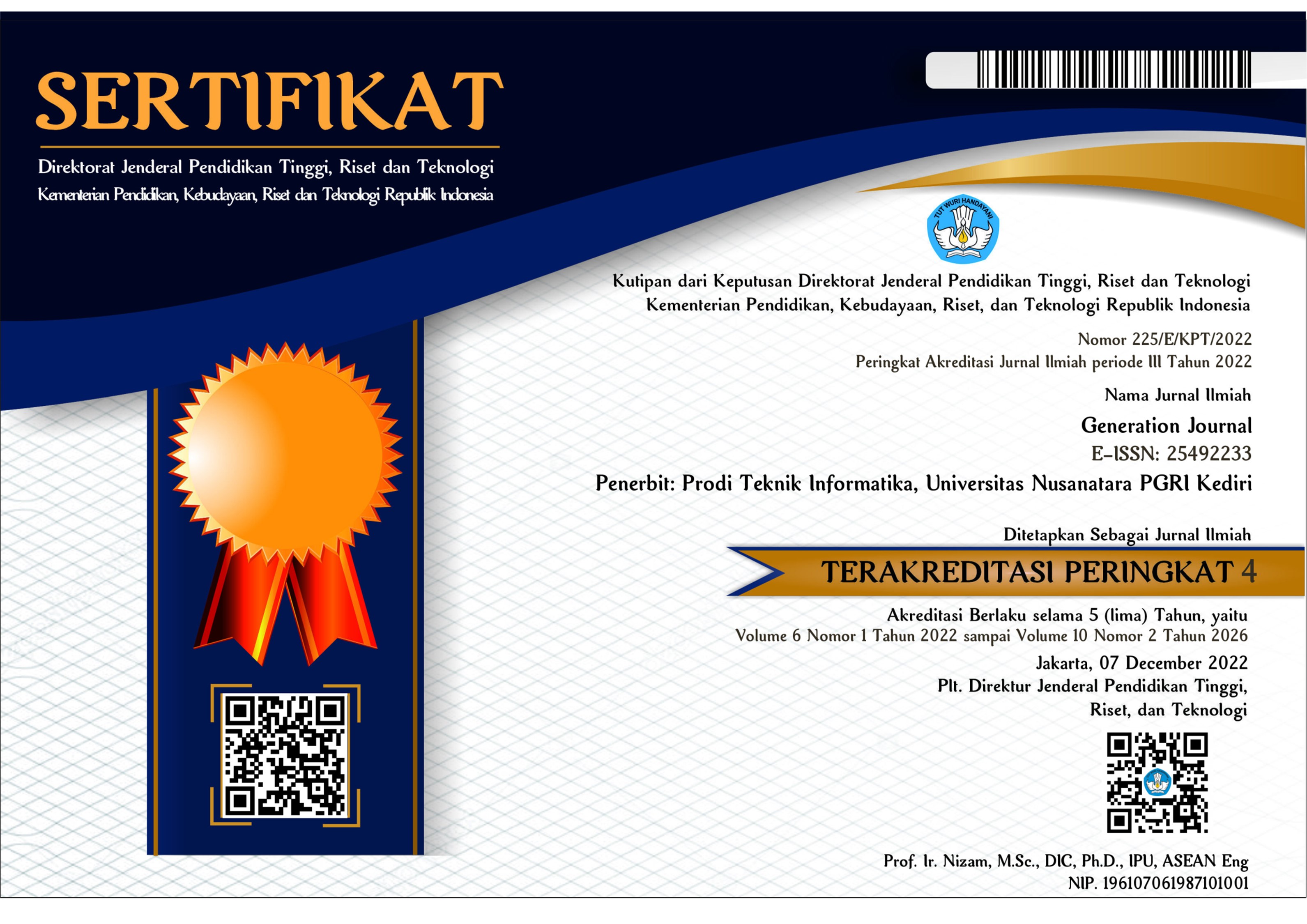Implementasi Algoritma Hill Cipher Menggunakan Kunci Matriks 2x2 Dalam Mengamankan Data Teks
DOI:
https://doi.org/10.29407/gj.v7i3.21105Keywords:
Hill Cipher, Cryptographic, Data Secure, Encryption, DecryptionAbstract
Sebagai sebuah negara yang besar, Indonesia harus bisa memastikan bahwa semua informasi yang dihimpun dalam setiap bidang pekerjaan aman. Banyaknya kasus peretasan akhir-akhir berdampak pada hilangnya kepercayaan dan rasa aman masyarakat kepada penyedia layanan yang dalam kegiatannya turut menghimpun data yang bersifat pribadi atau rahasia. Hal ini juga kekhawatiran apabila data tersebut disalahgunakan oleh pihak-pihak yang tidak bertanggungjawab. Langkah tepat dalam melindungi informasi adalah memperkuat keamanan data dengan menerapkan teknik kriptografi, yaitu teknik dalam menyamarkan data sebagai antisipasi apabila terjadi kebocoran data, informasi yang tersimpan didalamnya akan tetap aman. Penelitian ini berfokus pada bagaimana melakukan penyandian data teks dengan menggunakan algoritma kriptografi Hill Cipher dengan menggunakan kunci matriks dengan ordo 2x2.
References
M. Fadlan, S. Sinawati, A. Indriani, dan E. D. Bintari, “PENGAMANAN DATA TEKS MELALUI PERPADUAN ALGORITMA BEAUFORT DAN CAESAR CIPHER,” JURNAL TEKNIK INFORMATIKA, vol. 12, no. 2, hlm. 149–158, Nov 2019, doi: 10.15408/jti.v12i2.12262.
D. Maulana Sholahudin, “Implementasi Algoritma Hill Cipher untuk Proses Enkripsi dan Dekripsi Citra Berwarna dengan Modifikasi Padding”.
A. Amrulloh dan E. Ujianto, “Kriptografi Simetris Menggunakan Algoritma Vigenere Cipher,” Jurnal CoreIT, vol. 5, no. 2, 2019, [Daring]. Tersedia pada: https://program.arfianhidayat.com/kriptografi/vig
N. Siregar, I. Faisal, dan D. Handoko, “Menerapkan Algoritma Hill Cipher dan Matriks 2x2 Dalam Mengamankan File Teks Menggunakan Kode ASCII Apply Hill Cipher Algorithm and 2x2 Matrix in Securing Text Files Using ASCII Code,” 2022. [Daring]. Tersedia pada: https://jurnal.unity-academy.sch.id/index.php/jirsi/index70
A. A. Elhabshy, “Augmented Hill Cipher,” International Journal of Network Security, vol. 21, no. 5, hlm. 812, 2019, doi: 10.6633/IJNS.201909.
I. O. Nainggolan, W. M. Kementeri, P. R. I. Balai, D. Industri, dan M. Edan, “IMPLEMENTASI SANDI AFFINE UNTUK PENGAMANAN FILE MICROSOFT OFFICE Indra Oloan Nainggolan,” 2019.
U. Potensi Utama Jl KLYos, “RANCANG BANGUN APLIKASI KRIPTOGRAFI PADA TEKS MENGGUNAKAN METODE REVERSE CHIPER DAN RSA BERBASIS ANDROID Yusfrizal 1),” Jurnal Teknik Informatika Kaputama (JTIK), vol. 3, no. 2, 2019.
E. Setyawati, C. E. Widjayanti, R. R. Siraiz, dan H. Wijoyo, “Pengujian keamanan komputer kriptografi pada surat elektronik berbasis website dengan enkripsi metode MD5,” Jurnal Manajamen Informatika Jayakarta, vol. 1, no. 1, hlm. 56, Feb 2021, doi: 10.52362/jmijayakarta.v1i1.367.
Y. Dwi Putri, S. Lutfi, J. Jati Metro, dan K. Ternate Selatan, “PENERAPAN KRIPTOGRAFI CAESAR CIPHER PADA FITUR CHATTING SISTEM INFORMASI FREELANCE,” Jurnal Informatika dan Komputer) p-ISSN, vol. 2, no. 2, hlm. 2355–7699, 2019, doi: 10.33387/jiko.
D. Pangestu dan A. Syahputra, “PERANCANGAN APLIKASI KEAMANAN CLOUD DATABASE MENGGUNAKAN OPERASI XOR DENGAN ALGORITMA AFFINE BERBASIS ANDROID DESIGN OF CLOUD DATABASE SAFETY APPLICATIONS USING XOR OPERATION WITH AFFINE ALGORITHM BASED ON ANDROID,” 2020.
I. Muda Siregar, “PENERAPAN ALGORITMA AFFINE CIPHER DAN ALGORITMA COLOUMNAR TRANSPOSITION DALAM KEAMANAN TEKS,” 2019. [Daring]. Tersedia pada: http://www.stmik-budidama.ac.id,
L. S. Mezher dan A. M. Abbass, “Mixed Hill Cipher methods with triple pass protocol methods,” International Journal of Electrical and Computer Engineering, vol. 11, no. 5, hlm. 4449–4457, Okt 2021, doi: 10.11591/ijece.v11i5.pp4449-4457.
A. Susanto, I. Utomo, W. Mulyono, M. Rizky, F. Febrian, dan G. A. Rosyida, “A Combination of Hill Cipher and LSB for Image Security,” Scientific Journal of Informatics, vol. 7, no. 1, hlm. 2407–7658, 2020, [Daring]. Tersedia pada: http://journal.unnes.ac.id/nju/index.php/sjie
S. S. Al-Kaabi dan S. B. Belhaouari, “METHODS TOWARD ENHANCING RSA ALGORITHM : A SURVEY,” International Journal of Network Security & Its Applications, vol. 11, no. 03, hlm. 53–70, Mei 2019, doi: 10.5121/ijnsa.2019.11305.
R. K. Hasoun, S. Faris Khlebus, dan H. Kadhim Tayyeh, “A New Approach of Classical Hill Cipher in Public Key Cryptography,” 2021. [Daring]. Tersedia pada: http://www.ijnaa.semnan.ac.ir
K. Mani dan A. Barakath Begam, “Generation Of Keymatrix For Hill Cipher Encryption Using Quadratic Form,” INTERNATIONAL JOURNAL OF SCIENTIFIC & TECHNOLOGY RESEARCH, vol. 8, no. 10, 2019, [Daring]. Tersedia pada: www.ijstr.org
F. Qazi dkk., “Modification in Hill Cipher for Cryptographic Application. 3C Tecnología. Glosas de innovación aplicadas a la pyme,” Edición Especial, hlm. 240–257, 2019, doi: 10.17993/3ctecno.2019.
A. Susilo, Y. Irawan, dan N. Heryana, “Combination of Hill Cipher Algorithm and Caesar Cipher Algorithm for Exam Data Security,” Buana Information Tchnology and Computer Sciences (BIT and CS, vol. 1, no. 2, 2020.
L. Fidi Astuti, K. Agung Santoso, dan A. Kamsyakawuni, “PENGAMANAN POLYALPHABETIC DENGAN AFFINE CIPHER BERDASARKAN BARISAN FIBONACCI (Polyalphabetic Security with Affine Cipher Based on Fibonacci Sequence),” Majalah Ilmiah Matematika dan Statistika, vol. 19, hlm. 95–103, 2019, [Daring]. Tersedia pada: https://jurnal.unej.ac.id/index.php/MIMS/index
T. Khairani, K. A. Santoso, dan A. Kamsyakawuni, “PRISMA, Prosiding Seminar Nasional Matematika Pengkodean Monoalphabetic Menggunakan Affine Cipher dengan Kunci Diffie-Hellman,” vol. 4, hlm. 553–559, 2021, [Daring]. Tersedia pada: https://journal.unnes.ac.id/sju/index.php/prisma/
A. Tantoni, M. Taufan, dan A. Zaen, “IMPLEMENTASI DOUBLE CAESAR CIPHER MENGGUNAKAN ASCII,” Jurnal Informatika & Rekayasa Elektronika), vol. 1, no. 2, 2018, [Daring]. Tersedia pada: http://e-journal.stmiklombok.ac.id/index.php/jire
Downloads
Published
Issue
Section
License
Authors who publish with this journal agree to the following terms:
- Copyright on any article is retained by the author(s).
- The author grants the journal, the right of first publication with the work simultaneously licensed under a Creative Commons Attribution License that allows others to share the work with an acknowledgment of the work’s authorship and initial publication in this journal.
- Authors are able to enter into separate, additional contractual arrangements for the non-exclusive distribution of the journal’s published version of the work (e.g., post it to an institutional repository or publish it in a book), with an acknowledgment of its initial publication in this journal.
- Authors are permitted and encouraged to post their work online (e.g., in institutional repositories or on their website) prior to and during the submission process, as it can lead to productive exchanges, as well as earlier and greater citation of published work.
- The article and any associated published material is distributed under the Creative Commons Attribution-ShareAlike 4.0 International License













